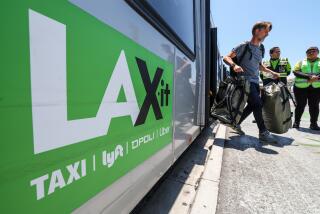Bus Service Fares Poorly for Lack of Ads : Transportation: Few are aware that the Ventura County service exists and ridership has been falling for the past three years, officials say.
It may not be the best or the fastest way to get from one end of Ventura County to the other, but itâs definitely one of the cheapest.
For $1.25, county residents can hop a bus in Thousand Oaks and in less than an hour enjoy the cool ocean breeze in Ventura. People from age 60 to 74 pay only 25 cents, and those 75 years and older ride for free.
But despite the low fares and a reputation for good service, bus ridership has never been as good as officials would like, they said. In fact, ridership has been on the decline for the last three years, from 38,316 passengers in 1987 to about 37,000 this year.
Part of the problem is that many people, such as Thousand Oaks resident Marion Schillinger, are unaware of the bus service.
The Interconnect Bus Service was set up in 1976 as part of a joint powers agreement between the county and the cities of Camarillo and Thousand Oaks to provide a means of transportation to those cities and to some unincorporated areas along the Ventura Freeway, said Kathy Connell, an official with the transportation division of the county Department of Public Works. The county is responsible for operating the bus service.
Although Schillinger has lived in the county for three years, she said, âThe transportation out here leaves a lot to be desired. Thatâs all I know about it.â
Schillinger drives, but she said she would prefer to take the bus. âIâve driven in Chicago, New York and other large cities, but I wonât drive on the 101,â she said. âThe drivers are extremely reckless out here.â
The reason Schillinger and others may not be aware of the bus service is that there is no money to advertise it, Connell said, adding that the service operates at a fairly large deficit.
She said Camarillo, Thousand Oaks and the county each pitch in $45,000 a year for a total of $135,000 to operate the bus transit system, which includes regular and express service. The operating cost for the 1989-90 fiscal year was $180,000.
Connell said that during the same period the bus service generated about $45,000 in fare box returns, representing 25% of its operating cost.
âIt is not a profitable situation,â Connell said. âBut the state mandates that we provide transportation between the cities. Itâs sort of a wash, basically.â
Bus driver Hugh Mulloy, 57, said he averages about 100 to 125 passengers a day, most of whom are senior citizens. He said he is convinced that the number of passengers would double if the service were advertised.
As it is, many of the stops do not even have signs or schedules posted. Even the busesâ exteriors do not advertise the service, although transit officials said that is about to change.
âThe problem is communication,â Mulloy said, adding that on his three months on the job he has seen only a small number of new passengers riding the bus. âMost people know about the bus simply from word of mouth. The people who know about it think itâs great.â
The bus currently stops at Buena Fashion Center in Ventura, Esplanade Shopping Center in Oxnard, Leisure Village in Camarillo, Conejo Industrial Park in Newbury Park and The Oaks mall and Westlake Plaza in Thousand Oaks.
The stops are from one hour to three hours apart between 6:45 a.m. and 5:30 p.m., Monday through Friday.
There is also early morning and late afternoon express service that includes stops at The Oaks mall in Thousand Oaks, Carmen Shopping Center in Camarillo, the Ventura County Government Center, Ventura College and the Ventura County Medical Center.
Those who do use the bus say they are pleased with the service.
âI use it every day,â said Henry Cruz, 79, of Thousand Oaks. âI canât find nothing wrong with it.â
Because he is over 75, Cruz rides for free. He said he often takes the bus to Ventura to go shopping or sightsee.
Kim Walling, 20, of Camarillo is also a regular passenger. Walling said she rides the bus four times a week to Ventura College, where she is a student.
âThe bus has been very helpful and convenient to me,â said Walling, who has been using the transit system for more than a year. âItâs cheaper than driving a car.â
It is also cheaper and, in some cases, more convenient than taking a taxi or other bus services.
For example, to take a cab from Thousand Oaks to Ventura would cost $40 to $45, said Robert Hitchcox, a dispatcher with American Cab Co., based in Thousand Oaks.
Another alternative would be to take Greyhound, which offers early morning and late afternoon service between Thousand Oaks and Ventura for $5 each way. It also offers service between Oxnard and Ventura for $3.20 each way.
The Great American Stageline bus also offers service from Thousand Oaks to Ventura for $5. That is, if the bus happens to stop in Thousand Oaks or Ventura.
Barbara Nigh, a Great American Stageline spokeswoman, said her company offers limited commuter service between county cities, but that its primary purpose is to provide county residents with transportation to and from Los Angeles International Airport.
Nigh said the bus picks up passengers 13 times a day in Ventura, Oxnard, Camarillo, Thousand Oaks and Westlake Village on its way to the airport.
She said that although many passengers use the bus to get from one county city to the next, they could find it difficult to get back home. The reason, Nigh said, is that buses returning from the airport will only stop in those cities that passengers on board request.
âIf there is no one to deliver in Thousand Oaks, it wonât stop,â Nigh said.
Meanwhile, Connell said, transit officials are hoping that ridership on the Interconnect Bus Service will increase once the county begins implementing a mandated trip reduction plan for all businesses with 100 or more employees. The mandate is the result of the stateâs 1989 Clean Air Act, which requires counties to initiate transportation control measures in order to reduce smog.
The first phase of the Ventura County program will require businesses with more than 100 employees to ensure that there are four passengers for every three cars traveling to and from the workplace.
Beginning in August, the county Air Pollution Control District, which is regulating the trip reduction program, will begin sending notices to all of the designated businesses informing them that they have 120 days to submit their plans, said Bill Mount, a district planning manager.
The district will have 60 days to approve the plans or request that some changes be made, Mount said.
Connell said the county is already putting a plan together for its 6,500 employees, which includes promoting other forms of transportation, such as car pools, van pools and riding the bus. She said her office has started sending out notices to all county employees about the Interconnect Bus Service.
In addition, she said, she is also sending flyers to libraries and municipal offices throughout the county informing people about the transit system.
More to Read
Sign up for Essential California
The most important California stories and recommendations in your inbox every morning.
You may occasionally receive promotional content from the Los Angeles Times.










